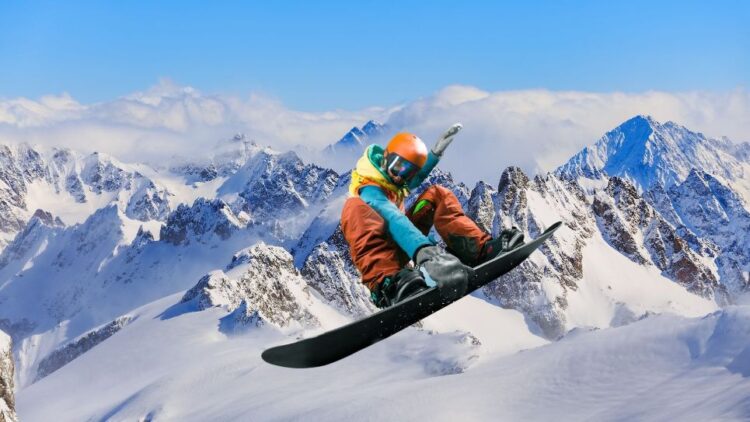
OBJECTIVE OF SNOWBOARDING: Either perform a series of trick and stunts that lands you the highest score or be the first to cross the finish line.
NUMBER OF PLAYERS: 1+ player(s)
MATERIALS: Snowboard, boots, bindings, helmets, goggles
TYPE OF GAME: Sport
AUDIENCE: 7+
OVERVIEW OF SNOWBOARDING
Competitive snowboarding is a winter sport that is often featured alongside skiing events. Essentially the winter version of skateboarding, snowboarding involves performing acrobatic tricks and stunts while gliding across the snow on a snowboard.
Historically, the first snowboard was invented in 1965 when a Michigan father invented what he called a “snurfer” (snow surfer) for his daughters. However, this contraption wasn’t really a board but rather just two skis fastened together and attached to a rope. After seeing how much his daughters enjoyed the gift, he went on to sell half a million snurfers in the following year after partnering with a largescale manufacturer.
A few years after its inception, snurfing events were held at major ski resorts. These events held at a ski resort led to multiple avid participants building upon the idea in later years, including Tom Sims and Jake Burton Carpenter. Sims is credited with creating the first board for modern snowboarding (a wooden plank covered with carpet and an aluminum-coated bottom), while Carpenter designed a board that came fitted with bindings (to attach the feet to the board). This led to Carpenter founding “Burton Snowboards” in 1977 at just 14 years old, with his company becoming the leading snowboard manufacturer even today.
Nowadays, snowboarding is an incredibly popular competitive and recreational sport that is participated in by millions of people worldwide. As an Olympic sport since 1998, snowboarding continues to be one of the most-watched winter sports.
SETUP
EQUIPMENT

- Snowboard: Snowboards are flat boards that feature a slick-coated bottom. These are substantially larger than skateboards, although the length and width differ depending on the type of event they’re being used for.
- Boots: Different styles of snowboarding boots exist, although most are softer and less rigid than skiing boots. They’re designed to provide ankle support while also being soft enough to allow ease of movement.
- Bindings: These are flexible straps that firmly secure the snowboarder’s feet to the board.
- Goggles: As with skiers, snowboards must wear goggles to help their vision when the sun glares off the snow, as well as to protect their eyes from the wind, snow, and possible obstacles like tree branches.
- Helmet: A standard hard helmet to protect against head trauma.
- Additional Equipment: Snowboarders should also wear gloves and layers of insulated clothing to remain warm.
GAMEPLAY

EVENTS AND SCORING
A total of five professional snowboarding disciplines are featured at the Winter Olympic sport. Some are centered around performing stunts and receiving points, while others are time-based races.
1) HALFPIPE
Possibly the most iconic snowboarding event, Halfpipe, takes place on a straight downhill course that has steeply sloped sides (forms a “U” shape). Each competitor gets two to three runs in which they perform numerous flips, spins, and other stunts while using the sloped sides of the course to get air time.
Shaun White grabs Snowboard Halfpipe Gold on his very last run | PyeongChang 2018
SCORING
Each run is scored by a panel of six judges. The judges give every run a score between 1–100, with the highest and lowest scores being omitted, while the others are averaged together.
Judges are critiquing the following aspects of a run:
- Amplitude: The more height an athlete is able to consistently reach from their jumps, the more points they receive.
- Difficulty: Challenging tricks and stunts score higher.
- Variety: Competitors should showcase a diverse array of stunts.
- Execution: The athlete should retain control both in the air and when they land from their stunts.
- Progression: Extra points are awarded for performing a series of stunts that fluidly fit together.
2) BIG AIR
This event takes place on a massive hill that features a large ascending ramp in the middle of it. One at a time, each competitor starts at the top of the hill, gathers as much speed as they can, and takes flight off the mid-hill ramp to perform an intense mid-air stunt while trying to stick the landing at the bottom of the hill. Competitors are generally given three attempts per round.
Men’s Snowboard Big Air: HIGHLIGHTS | X Games Aspen 2022
SCORING
Similar to Halfpipe, Big Air runs are scored by a panel of six judges out of a maximum score of 100 (with the four middle scores being averaged together). These runs are also judged using a similar criterion (difficulty, execution, and amplitude), although the fourth scoring category concerns how cleanly a competitor can stick the landing after their stunts (including how centered they are).
3) PARALLEL GIANT SLALOM
Snowboarders compete in head-to-head matchups in which they race side-by-side down a slalom course while weaving around numerous “gates”. One competitor races down the red side course while the other races down the blue side. Both sides are mirrored, and the highest-seeded athlete (determined by preliminary timed runs) gets to choose which side they want.
Men’s Snowboard – Parallel Giant Slalom – Vancouver 2010 Winter Olympic Games
SCORING
The initial preliminary rounds seed competitors based on the finishing times of their two initial runs. In the later elimination/head-to-head bracket rounds, the first competitor to reach the finish line wins the race and advances to the next round.
4) SNOWBOARD CROSS
Heats of competitors (often four in number) race side-by-side down a course toward a finish line. These courses consist of numerous bumps, turns, jumps and always end with a sizeable downhill slope (similar to the one used in Big Air events).
🏂 Incredible snowboard cross races at #Beijing2022
SCORING
As this is a racing event, competitors are ranked based on the order in which they cross the finish line, with each heat often including four athletes, the top two finishers in each race advance to the next round. In the final round, medals are awarded to the first three athletes who cross the finish line.
5) SLOPESTYLE
Competitors are given two runs per round to traverse down a long obstacle-filled course complete with ramps, halfpipes, rails, large hills, etc. Similar to the Halfpipe event, competitors are scored by a panel of judges.
Snowboard Beijing 2022 | Women’s slopestyle final highlights
SCORING
This event is scored by a panel of nine judges. Three judges are responsible for critiquing the overall impression of the run (worth 40% of the total score), while the other six judges are split into groups of two, with each group judging the athlete’s performance at a specifically assigned portion of the course (worth a combined 60% of the total score).
Slopestyle runs are judged using the same criterion as Halfpipe (amplitude, difficulty, variety, execution, and progression).
RECREATIONAL SNOWBOARDING
Despite having a lush competitive scene, alpine snowboarding is similar to skateboarding in the sense that it attracts a sizeable number of recreational participants who treat the sport more as a lifestyle rather than just a hobby. This subculture of snowboarders stemmed from the initial pushback of regular skiers who considered snowboarders to be an annoyance or hindrance on their slopes.
Instead of letting the negative attention tear them down, many snowboarders started embracing the “rebellious” nature of their sport in a way similar to skateboarders and surfers. This led snowboarders to rewrite their entire image—one centered around punk, hip-hop, and a vocabulary largely consisting of the words “gnarly” and “dude”.
As the sport of snowboarding grew to new audiences, this rebellious lifestyle began to disappear as the animosity between them and skiers quickly dissipated. Nowadays, snowboarding’s subculture is less prominent, although many participants still associate more with the skateboarding culture and image than that of skiing.
END OF GAME
Depending on the event, snowboarding competitions are won by the competitors who receive the highest score from the judges (Big Air, Halfpipe, and Slopestyle) or are the first to cross the finish line (Parallel Giant Slalom, Snowboarding Cross).
- 30 GAMES TO PLAY OVER TEXT - April 22, 2024
- 20+ FREE PRINTABLE BABY SHOWER GAMES - April 16, 2024
- 20+ College Party Games for the Best Night Ever! - April 2, 2024